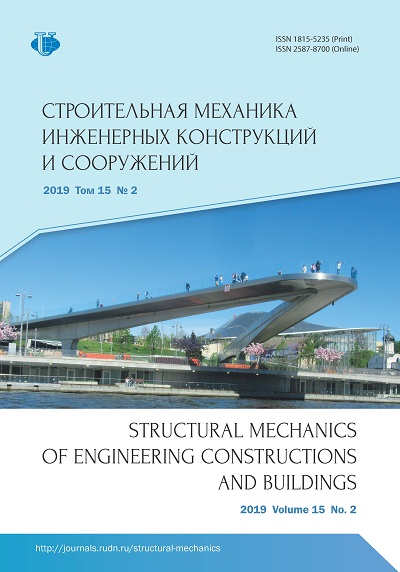Extraction of consistent shell theory equations from 3D theory of elasticity
- Authors: Zveryaev E.M1,2
-
Affiliations:
- Keldysh Institute of Applied Mathematics
- Moscow Aviation Institute (National Research University)
- Issue: Vol 15, No 2 (2019)
- Pages: 135-148
- Section: Theory of elasticity
- URL: https://journals.rudn.ru/structural-mechanics/article/view/21081
- DOI: https://doi.org/10.22363/1815-5235-2019-15-2-135-148
Cite item
Full Text
Abstract
Aims of research. Derivation of consistent equations of the theory of thin elastic shells without hypotheses and stress averaging over the shell thickness. Methods. Using the iterative method of Saint-Venant - Picard - Banach, the three-dimensional problem of the theory of elasticity is solved without any hypotheses. By the principle of compressed mappings, the solution converges asymptotically, regardless of the choice of the values of the initial approximation. Results. A method has been developed for integrating the spatial equations of the theory of elasticity in curvilinear coordinates for a thin shell. The presence of a small parameter allows the integration of the system of equations in such a way that the output data of the first operator is input to the next operator, etc., dividing the original complex operator into a sequence of simple integrable Picard type operators. Each equation contains terms of only one asymptotic order.
About the authors
Evgeny M Zveryaev
Keldysh Institute of Applied Mathematics; Moscow Aviation Institute (National Research University)
Author for correspondence.
Email: zveriaev@mail.ru
Doctor of Technical Sciences, Professor, Keldysh Institute of Applied Mathematics, Moscow Aviation Institute (National Research University).
4 Miusskaya Sq., Moscow, 125047, Russian Federation; 4 Volokolamskoe Shosse, Moscow, 125993, Russian FederationReferences
- Love A.E.H. (1927). A Treatise on the Mathematical Theory of Elasticity. Cambridge: Univ. Press., 674.
- Novozhilov V.V., Finkel'shtejn R.M. (1943). O pogreshnosti gipotez Kirhgofa - Lyava v teorii obolochek [On the error of Kirchhoff - Love hypotheses in the theory of shells]. PMM, 7(5), 323-330. (In Russ.)
- Koiter W.T. (1960). A consistent first approximation in the general theory of thin elastic shells. Proc. IUTAM Symp. On the theory of thin elastic shells (Delft. 1959). Amsterdam, North-Holland Publishing Company, 12-33.
- Vlasov V.Z. (1949). Obshchaya teoriya obolochek i ee prilozheniya v tekhnike [The General Shells Theory and its Application in Technology]. Moscow: Gostekhizdat Publ., 784. (In Russ.)
- Lur'e A.I. (1947). Statika tonkostennyh uprugih obolochek [Statics of thin-walled elastic shells]. Moscow: Gostekhizdat Publ., 252. (In Russ.)
- Novozhilov V.V. (1964). Thin shell theory. 2nd ed. The Netherlands, 432.
- Gol'denvejzer A.L. (1976). Teoriya tonkih uprugih obolochek [Theory of Elastic Thin Shells]. Moscow: Nauka Publ., 512.
- Reissner E. (1971). On consistent first approximations in the general linear theory of thin elastic shells. Ing. arch, 40(6), 402-419. doi.org/10.1007/BF00533975
- Başar Y., Krätzig W.B. (2001). Theory of shell structures. 2nd ed. Düsseldorf: VDI Verlag.
- Zveriaev E.M. (1970). On elasticity relationships in the linear theory of thin elastic shells. Prikl. Mat. Mekh., 34(6), 1136-1138.
- Rogachova N.N. (1974). On the Reissner - Naghdi elasticity relationship. Prikl. Mat. Mekh., 38(6), 1063-1071.
- Vasil'ev V.V. (2012). O preobrazovaniyah Tomsona - Tehta v klassicheskoj teorii plastin [Kirchhoff and Thomson - Tait Transformations in the Classical Theory of Plates]. MTT, (5), 98-107. (In Russ.)
- Zveryaev E.M. (2018). Metod Sen-Venana - Pikara - Banaha integrirovaniya uravnenij v chastnyh proizvodnyh s malym parametrom [The Saint-Venant - Picard - Banach method of integrating equations in partial derivatives with a small parameter]. Preprinty IPM imeni M.V. Keldysha, (83), 19. doi: 10.20948/prepr-2018 (In Russ.)
- Zveryaev Ye.M. (2016). Neprotivorechivaya teoriya obolochek [A consistent theory of thin elastic shells]. Prikl. Mat. Mekh., 80(5), 580-596. (In Russ.)
- Zveryaev E.M. (2016). Konstruktivnaya teoriya tonkih uprugih obolochek [Constructive theory of thin elastic shell]. Preprinty IPM imeni M.V. Keldysha, (33), 25. doi: 10.20948/prepr-2016-33. (In Russ.)
- Zveryayev Ye.M. (2008). Analiz gipotez, ispol'zuemykh pri postroenii teorii balok i plit [Analysis of hypotheses used when constricting the theory of beams and plates]. Prikl. Mat. Mekh., 67(3), 472-481. (In Russ.)
- Zveryayev Ye.M., Makarov G.I. (2008). Obshchii metod postroeniya teorii tipa Timoshenko [A general method for constructing Timoshenko-type theories]. Prikl. Mat. Mekh., 72(2) 308-321. (In Russ.)
- Zveryaev E.M. (2014). Vydelenie uravnenij tipa Timoshenko iz prostranstvennyh uravnenij teorii uprugosti dlya plastiny na osnove principa szhatyh otobrazhenij [Isolation of type Timoshenko equations from spatial theory elasticity plate equations on the base contraction mapping principle]. Trudy MAI, (78), 1-22. http://www.mai. ru/upload/iblock/8b4/8b4dff2e41bb50a03dfe08744877a2c f.pdf. (In Russ.)
- Friedrichs K.O. (1950). Kirchhoff’s boundary conditions and the edge effect for elastic plates. Poc. Symp. Appl. Math., (3), 117-124.
- Friedrichs K.O., Dressler R.F. (1961). A boundarylayer theory for elastic plates. Comm. Pure Appl. Math., (14), 1-33.
- Zveryaev E.M., Olekhova L.V. (2015). Iteracionnaya traktovka poluobratnogo metoda Sen-Venana pri postroenii uravnenij tonkostennyh ehlementov konstrukcij iz kompozicionnogo materiala [Iterative interpretation of Saint-Venant semi-inverse method for construction of composite material thin-walled structural elements equations]. Trudy MAI, (79), 1-27. http://www.mai.ru/upload/iblock/ 876/8767af08970b8e67ef0a1b71d2763cd0.pdf. (In Russ.)
- Zveryaev E.M., Olekhova L.V. (2014). Svedenie trekhmernyh uravnenij NDS plastiny iz kompozicionnogo materiala k dvumernym na baze principa szhatyh otobrazhenij [Reduction 3D equations of composite plate to 2D equations on base of mapping contraction principle]. Preprinty IPM imeni M.V. Keldysha, (95), 29. http://keldysh.ru/ papers/2014/prep2014_95.pdf. (In Russ.)
















